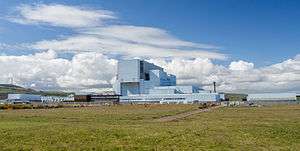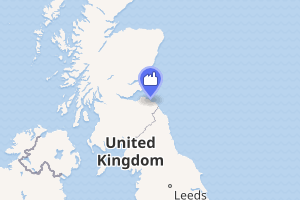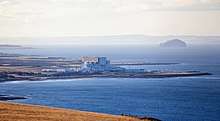Torness Nuclear Power Station
Torness Nuclear Power Station is a nuclear power station located approximately 30 miles (50 km) east of Edinburgh at Torness Point near Dunbar in East Lothian, Scotland. It was the last of the United Kingdom's second generation nuclear power plants to be commissioned. Construction of this facility began in 1980 for the then South of Scotland Electricity Board (SSEB) and it was commissioned in 1988. It is a local landmark, highly visible from the main A1 road and East Coast Main Line railway.
| Torness Nuclear Power Station | |
|---|---|
 | |

| |
| Country | Scotland |
| Location | Dunbar, East Lothian |
| Coordinates | 55.96799°N 2.40908°W |
| Status | Operational |
| Construction began | 1980 |
| Commission date | 1988 |
| Operator(s) | |
| Nuclear power station | |
| Reactor type | AGR |
| Power generation | |
| Units operational | 2 × 682 MWe |
| Nameplate capacity | 1,364 MWe |
| External links | |
| Commons | Related media on Commons |
History
After extensive discussions with the local planning authority and more than twenty other interested organisations, the SSEB sought approval of the Secretary of State for Scotland in 1973 for Torness as a site for a nuclear power station. A public exhibition was held at Dunbar in February 1974 to explain the Board's proposals, and in June 1974, a public inquiry was held.[1]
There was widespread public opposition to the building of a nuclear plant at Torness. Diverse campaigning groups came together to highlight the environmental and human cost of nuclear power stations. In May 1978 4000 people marched from Dunbar to occupy the Torness site. Many of them signed a declaration to “take all nonviolent steps necessary to prevent the construction of a nuclear power station at Torness”.[2]
The SSEB submitted designs for four types of reactor then being considered by HM Government for the next stage of the UK civil nuclear programme: the advanced gas-cooled reactor (AGR), the Steam Generating Heavy Water Reactor (SGHWR), the Light Water Reactor (LWR) and the High Temperature Reactor (HTR). In February 1975, the Secretary of State for Scotland granted the SSEB statutory consent for the location of future nuclear power stations and, after review of the four alternative reactor types, consent was given on 24 May 1978 for construction of the AGR station.
The construction, which was undertaken by a consortium known as National Nuclear Corporation ('NNC'),[3] began in 1980. The reactors were supplied by NNC, the boilers by NEI and the turbines by GEC.[4]
Torness was the last of the United Kingdom's second generation nuclear power plants to be commissioned (25 May 1988). The station consists of two advanced gas-cooled reactors (AGR) capable of producing a peak rating of 1364 MWe. Upon deregulation of the United Kingdom's electricity generation market it passed to the state-owned Scottish Nuclear, privatised as part of British Energy which was sold to the French company EDF in January 2009, and incorporated in the latter's UK subsidiary EDF Energy. It is expected to operate until 2030.[5]
Plant design

Torness shares its design with Heysham 2 nuclear power station. The station was designed by NNC, a company created from the gradual amalgamation of five consortia that were formed in the 1950s and 1960s to build the UK's commercial nuclear power stations. NNC is now part of Jacobs Engineering Group. [6]
The graphite-moderated, gas-cooled design was proven at the WAGR – the Windscale experimental AGR facility and is a significant evolution of the Magnox reactor designs. The entire UK commercial reactor programme shares a common heritage with, and was built on operating experience gained from the early PIPPA reactors at Calder Hall and Chapelcross and prior to that, the Windscale piles.
When first operated Torness probably had the most sophisticated and complex computerised control system for a nuclear power station worldwide, and a far more sophisticated than earlier members of the advanced gas-cooled reactor fleet. Over 70 Ferranti Argus 700 computers are used in the control and instrumentation systems, which included Digital Direct Control (DDC) of the reactors.[7][8]
Nuclear fuel for Torness power station can be delivered and removed via a loading/unloading facility on a branch from the adjacent East Coast Main Line.[9]
Operating experience and incidents
Details of incidents are published on the web site of the Health and Safety Executive in its quarterly statements of nuclear incidents at nuclear installations[10] and quarterly inspection reports for each nuclear licensed site.
Crash of an RAF Tornado near the site - November 1999
In November 1999 an RAF Panavia Tornado F.3 crashed into the North Sea less than 1 km from the power station following an engine failure. The UK Ministry of Defence commended the two crew members for demonstrating "exceptional levels of airmanship and awareness in the most adverse of conditions", because they ensured that the Tornado was clear of the power station before abandoning the aircraft.[11]
Failure of a gas circulator – May 2002
This was thought, from forensic evidence, to be linked to the development of an unexpected fatigue-related crack in part of the impeller. In August, another gas circulator on the other Torness reactor showed signs of increasing vibration and was promptly shut down by the operators. Its subsequent disassembly revealed a fully developed fatigue related crack in a similar position to the first failure, but the prompt shutdown had prevented consequential damage.[12]
Unplanned power excursion – December 2005
An unplanned power increase on Reactor 2 at Torness during the night shift of 30 December 2005. Operators responded to the event by taking corrective action to restore normal core reactivity levels. Station and Company investigations identified that improvement to the training of operators covering reactivity fundamentals is appropriate.[13]
Shutdown after drumscreen blockage by seaweed – August 2006
Complete blockage by seaweed of the main cooling water intake drum-screens is an initiating event considered in the Station Safety Report (SSR). The event resulted in supplies of main cooling water being lost for a period. As a consequence, water supplies to the reactor seawater (RSW) system, which provides a safety role, were lost for a time on one reactor and restricted on the other. The station responded to the event by shutting down both reactors within 70 minutes of receiving the first indication of impaired main cooling water flow and provided adequate post trip cooling.[14]
Shutdown after sea-water intake blockage by jellyfish – June 2011
On 28 June 2011[15] both reactors were manually shut down due to reduced flow of sea water at intakes by a large mass of jellyfish.[16]
See also
- Nuclear power in Scotland
- Nuclear power in the United Kingdom
- Energy policy of the United Kingdom
- Energy use and conservation in the United Kingdom
- James L. Gray (SSEB Chief Engineer)
- List of places in East Lothian
References
- "Scottish Government files Page 125" (PDF). Retrieved 3 July 2011.
- "Corporatewatch Report 2007". Archived from the original on 20 July 2011. Retrieved 3 July 2011.
- "UK Experience of Consortia Engineering for Nuclear Power Stations: Critical Again - Lessons for New UK Nuclear Power Projects" (PDF). Archived from the original (PDF) on 3 October 2011. Retrieved 3 July 2011.
- "Nuclear Power Plants in the UK - Scotland and Wales". Archived from the original on 19 July 2009. Retrieved 3 July 2011.
- "Edinburgh Evening News - Torness". Retrieved 16 February 2016.
- Jacobs snaps up Wood’s nuclear business for £250m (Report). Building - Assemble Media Group. 9 March 2020. Retrieved 11 April 2020.
- Computerization of Operation and Maintenance for Nuclear Power Plants (PDF) (Report). IAEA. July 1995. pp. 159–168. ISSN 1011-4289. IAEA-TECDOC-808. Retrieved 8 October 2016.
- W.J.Hill, N.M.Mitson (8 May 1990). Building of the Auto Control Software for Torness NPS (PDF) (Report). The Institution of Nuclear Engineers. p. 25. Retrieved 8 October 2016.
- Brailsford, Martyn (2017). Railway Track Diagrams Book 1: Scotland & Isle of Man. Frome: Trackmaps. pp. 11C. ISBN 978-0-9549866-9-8.
- http://www.hse.gov.uk/nuclear/quarterly-stat/
- Pilots praised over Tornado crash BBC News, 11 March 2002
- Statement of nuclear incidents at nuclear installations 1 July 2002 - 30 September 2002 HSE, 2002
- British Energy Generation (UK) Ltd Torness Power Station Quarterly report for 1 April to 30 June 2006 Archived 28 September 2007 at the Wayback Machine HSE, 2006
- Nuclear Safety Newsletter Archived 27 September 2007 at the Wayback Machine HSE, December 2006
- IAEA IRS report dated 30 October 2012 (not public)
- "Jellyfish force Torness nuclear reactor shutdown". BBC News. 30 June 2011. Retrieved 30 June 2011.
External links
- Heysham 2/Torness, Nuclear Engineering International wall chart, 1981
- Account of visiting Torness by Charlie Stross